A small multi-cultural island in tropical Asia and an ancient city in the heartland of the South of France wouldn’t seem on the face of it to have much in common. But appearances can be deceptive, and one of the delights of a recent talk by Julia de Bierre at the newly refurbished Star Building in Pitt Street was the discovery of the links between unlikely twins.
Julia de Bierre herself is a living link as she was born in Penang and spent much of her childhood here. I didn’t know Julia in those days though I remember her parents, Fred and Hazel Weatherly, coming to dinner with my parents. We were near contemporaries at Uplands School which is soon to celebrate its Diamond Jubilee and which was then situated on Penang Hill. Although Julia and I took different paths in life subsequently, both of us were drawn back to Penang. For Julia, this has meant the project of renovating a shop house in Muntri Street in George Town both as a home and a photography gallery and also writing a book on Penang’s heritage architecture. Enough work, one might think, but Julia also has a dual life in France. She has restored a much grander mansion in the centre of Arles as a guest house, a gallery, and an artist’s residence.
“Rumah in Arles” was held there as part of the Marseille-Provence Capital of Culture celebrations in 2013. Rumah is the Malay word for house and for the show Julia turned her Provencal kitchen into a Nyonya pantry. I wondered if the native Arlesians were surprised by the tastes of Penang but, upon reflection, many of Provence’s culinary flavours are derived from Roman influences – including coriander, cumin, mint, and garlic – so perhaps it wasn’t so strange for them to taste Penang Laksa, Pie Tee, or Kari Kapitan. Less than a hundred kilometres from Arles is the great sea port of Marseilles which where the spices from the East were unloaded in the olden days. Another link between Provence and Southeast Asia is Patchouli, a shrub whose leaves were used as packing for Chinese silk being exported to Europe. Patchouli was considered to be a powerful insect repellent and also kept moths from eating the valuable silks on their long journey. The spicy, strong aroma of patchouli thus became associated with luxury goods and nowadays patchouli oil, the hippy scent of the 1960s, is the basis of many of the high end perfumes of Provence.
Of course Penang and Arles share the fact that they are both post-imperial towns. Arles was a flourishing city under the Roman Empire and its magnificent arena (where bullfights are still held), its 10,000- seat theatre and the Baths of Constantine are part of that heritage. Although Penang’s British colonial era buildings are far less impressive, they are now equally well preserved and formed part of the historical legacy that won George Town UNESCO World Heritage status in 2008. Arles had received similar recognition a quarter of a century earlier. Both Penang and Arles face similar problems in terms of keeping the balance between preserving and conserving the past and encouraging future development and investment. Tourism is an important earner for both cities. One of Arles’s strategies is to become an international creative city and thus attract visitors who are interested in culture. Its annual photography exhibition is now recognized as one of the finest in the world. Penang still has some way to equal that although the George Town Festival, now in its sixth year, is gathering momentum.
One of the great ironies is that the painter most associated with Arles wasn’t French – he was the Dutchman, Vincent van Gogh. Perhaps it just underscores the fact that art is international – a point which Malaysia perhaps could do well to recognize. Julia noted that the café which forms the subject of one van Gogh’s most famous works – “Café Terrace at Night” – still exists over a hundred years on. In the scene it’s late and most of the diners have left the pavement café in a cobbled street upon which luminous starlight falls. It could almost be George Town a few years hence when the battle with the motor car has finally been won and, like present-day Arles, the city is finally pedestrianised.
Julia will be bringing a group of Penang artists to Arles for her next show “Rumah 2015”. I wonder if they will realise that the distinctive half-moon roof tiles of the old buildings of Arles were made by the same factory that produced the heritage tiles of George Town? When the cargoes of spices, teas, and other goods were sent to Europe, these terracotta tiles, stamped “Marseilles” were sent back as ballast. Perhaps the inhabitants of George Town and those of Arles really do sleep under the same roof after all.
Julia de Bierre, Penang Behind Gilded Doors, Areca Books
Read This: 20 Music Artists Created in Legos by a Malaysian
Source: The Expat Magazine December 2014
"ExpatGo welcomes and encourages comments, input, and divergent opinions. However, we kindly request that you use suitable language in your comments, and refrain from any sort of personal attack, hate speech, or disparaging rhetoric. Comments not in line with this are subject to removal from the site. "


















